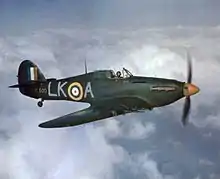No. 87 Squadron RAF
No. 87 Squadron RAF was an aircraft squadron of the Royal Air Force during the First World War and Second World War.
| No. 87 Squadron RAF | |
|---|---|
| Active | 1 September 1917 – 24 June 1919 15 March 1937 – 30 December 1946 1 January 1952 – 3 January 1961 |
| Country | |
| Branch | |
| Motto(s) | Latin: Maximus me metuit ("The most powerful fear me")[1] A "lazy S" mark, based on Wild West-style ranch branding, was the squadron's World War One identity marking early in its existence, this became a serpent in the badge.[2] |
| Insignia | |
| Squadron badge heraldry | A serpent reversed, head reguardant and tail embowed.[2] |
| Squadron Roundel |  |
| Squadron codes | PD Oct 1938 - Sep 1939 LK Sep 1939 - Dec 1946 B Jan 1952 - Jan 1961 |
World War I
87 Squadron Royal Flying Corps (RFC) was first formed on 1 September 1917 at Upavon from elements of the Central Flying School. On 17 December 1917, it moved to Hounslow Heath Aerodrome and was equipped with Sopwith Dolphins and S.E.5As, moving on to France in April 1918. After the armistice, the squadron moved back to England and was disbanded at RAF Ternhill on 24 June 1919.[3] The squadron did have seven aces on this type, in Arthur Vigers DFC, future Air Chief Marshal Leslie Hollinghurst, Henry Biziou, Joseph Callaghan (a commanding officer of 87 Squadron for a time, just achieving ace status with the Dolphin by war's end), Charles Darwin, Herbert Joseph Larkin, Alexander Pentland, and Charles Edward Worthington.[4] The squadron's "lazy-S" style insignia in use late in World War I on its Dolphins is said to have been authorized for use by CO Callaghan, whose pre-war time living in Texas, where livestock branding on ranch livestock was common there at that time, could have inspired his choice of squadron insignia.[5]
World War II

87 Squadron was re-formed on 15 March 1937 at RAF Tangmere from elements of No. 54 Squadron RAF, operating the Hawker Fury. At the outbreak of the Second World War, the squadron was part of the air element of the British Expeditionary Force in France, equipped with Hawker Hurricanes. Flight Lieutenant Ian Gleed was posted to the squadron as a replacement pilot on 17 May 1940 and became an ace in two days. He took command of the squadron in December 1940 when it was based at RAF Charmy Down.[6][7]
John Strachey MP served as the intelligence officer for the squadron during the Battle of Britain.[8]
In July 1944 87 Squadron became one of two RAF Squadrons to join No. 8 Wing SAAF (the other being RAF 185 Squadron) and began fighter-bomber operations supporting the fighting in Italy as well as taking part in offensive sweeps across the Balkans from its detached Italian bases. It continued in this role in the Italian Campaign until the end of the war.[9]
The Cold War
87 Squadron was again re-formed as part of the 2nd Tactical Air Force in Germany on 1 January 1952 at RAF Wahn with the Gloster Meteor NF11, with the main tasking being the defence of the Ruhr, after five years it moved to RAF Bruggen, and was equipped with the Gloster Javelin as an all-weather interceptor force until it was disbanded on 3 January 1961.
Aircraft


| Dates | Aircraft | Variant | Notes |
|---|---|---|---|
| 1917–1919 | Sopwith Dolphin | Single-engined piston biplane fighter | |
| 1937-1937 | Hawker Fury | II | Single-engined piston biplane fighter |
| 1937–1938 | Gloster Gladiator | I | Single-engined piston biplane fighter |
| 1938–1942 | Hawker Hurricane | I | Single-engined piston monoplane fighter |
| 1941–1944 | Hawker Hurricane | IIC | |
| 1943–1944 | Supermarine Spitfire | IX, VB, VC VIII | Single-engined piston monoplane fighter |
| 1944–1946 | Supermarine Spitfire | IX | |
| 1952–1957 | Gloster Meteor | NF11 | Twin-engined jet night fighter |
| 1957–1961 | Gloster Javelin | FAW1 | Twin-engined jet fighter |
| 1958–1960 | Gloster Javelin | FAW5 | |
| 1959–1961 | Gloster Javelin | FAW4 |
Notable pilots
World War I
World War II
Notes
- Pine, L.G. (1983). A dictionary of mottoes (1 ed.). London: Routledge & Kegan Paul. p. 136. ISBN 0-7100-9339-X.
- "87 Squadron". Royal Air Force. Archived from the original on 15 October 2012. Retrieved 26 January 2016.
- Halley (1988)
- http://www.theaerodrome.com/aircraft/gbritain/sopwith_dolphin.php?pageNum_aces=0&totalRows_aces=27#aces Retrieved on 10 June 2010.
- Franks, Norman (2002). Osprey Aircraft of the Aces #48 - Dolphin and Snipe Aces of World War 1. Oxford, UK: Osprey Publishing Ltd. pp. 62–66. ISBN 1-84176-317-9.
- "Wing Commander Ian Richard Gleed". www.hatfield-herts.co.uk. Retrieved 5 January 2018.
- Roffey, Len (19 September 1980). "RAF 10 Group HQ Reminiscences - Part 1". BBC. Retrieved 29 April 2019.
- Gleed, Ian (1942). Arise to conquer. London: Grub Street. p. vii. ISBN 978-1906502935.
- H.J Martin, Neil Orpen (1977). Eagles Victorious: The S.A.A.F. in Italy and the Mediterranean: 1943 - 1945. Cape Town: Purnell. p. 231.
- Jefford 1988, page 51
References
Bibliography
- The Illustrated Encyclopedia of Aircraft (Part Work 1982-1985). Orbis Publishing. 1985.
- Halley, James J. 1988. The Squadrons of the Royal Air Force & Commonwealth 1918–1988. Air Britain ISBN 0-85130-164-9.
- Jefford, C.G. (1988). RAF Squadrons. Airlife Publishing Ltd. ISBN 1-85310-053-6.
- Orpen, Neil (1977). Eagles Victorious: The S.A.A.F. in Italy and the Mediterranean: 1943 - 1945. Purnell. ISBN 0-86843-008-0.